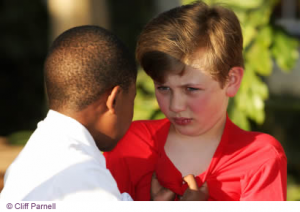As soon as children are old enough to interact socially, some become entrenched in chronic and increasing patterns of victimization by their peers, according to a report in the October issue of Archives of General Psychiatry, one of the JAMA/Archives journals. Children who are aggressive in infancy and are from families with harsh parenting styles and insufficient income appear more likely to be consistently victimized.
As many as one in 10 youth are the direct target of physical attacks, hostile words and social aggression from peers during school years, according to background information in the article. “Studies also show that peer victimization becomes increasingly stable over time, with the same children enduring such negative experiences throughout childhood and adolescence,” the authors write. “The consequences associated with high and chronic victimization are manifold and include depression, loneliness, low self-esteem, physical health problems, social withdrawal, alcohol and/or drug use, school absence and avoidance, decrease in school performance, self-harm and suicidal ideation [thoughts and behaviors].”
Edward D. Barker, Ph.D., of the University of Alabama, Tuscaloosa, and colleagues studied 1,970 children (51 percent boys) born in Québec, Montreal, Canada, between October 1997 and July 1998. Participating children were assessed at ages 4.5 months, 16.6 months, and 2.4, 3.4, 4.1, 5.1, 6.2 and 7.2 years. At each point, mothers provided information on factors such as victimization, family adversity, parenting styles, physical aggression, hyperactivity and internalizing symptoms. At age 7.2 years, teachers and children reported on victimization by classmates.
“Three trajectory groups were identified with respect to victimization by peers between 3.4 and 6.2 years of age,” the authors write. “As expected, most of the children (71 percent) fell on a low/increasing trajectory, whereas 25 percent and 4 percent of the children followed moderate/increasing and high/chronic trajectories, respectively. The overall age-related increase in preschool peer victimization is consistent with the view that, as preschool children progressively spend more time interacting with peers, they are more likely to experience negative peer experiences.”
Children who were on the high/chronic and moderate/increasing trajectory according to their mothers’ reports at young ages also had the highest levels of victimization at age 7.2, as reported by themselves and their teachers. Children who were aggressive at a young age (17 months) were more likely to become victims in preschool than children who were less aggressive, but neither early internalizing symptoms (for example, sadness, fear and anxiety) or hyperactivity were associated with later victimization. Children exposed to harsh parenting were more likely to be chronic victims, and insufficient family income also predicted high/chronic and moderate/increasing victimization trajectories.
In addition to identifying factors associated with victimization, “the present results also suggest that multiple forms of victimization may be the norm for victimized children, i.e., children with a high/chronic trajectory had harsh, reactive parents and were victimized by peers in preschool and after school entry. Other forms of victimization are likely to occur for these children, both within the school (e.g., verbal bullying by teachers) and within the community, particularly within low socioeconomic contexts,” the authors write. “These results suggest that early preventive interventions should target both child- and parent-level risks and focus on alternatives to harsh and aggressive interactions.”
Source: American Medical Association , via Newswise (Arch Gen Psychiatry. 2008;65[10]:1185-1192.

